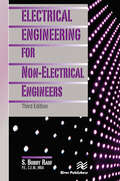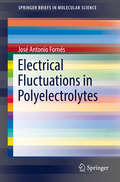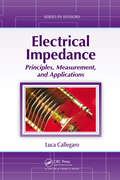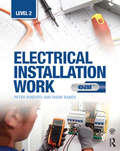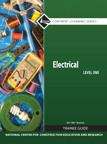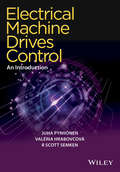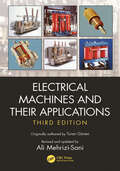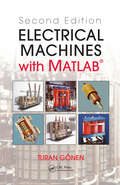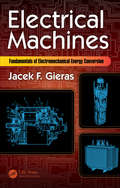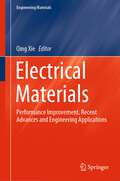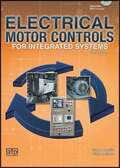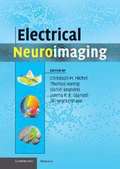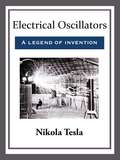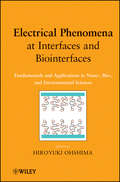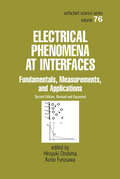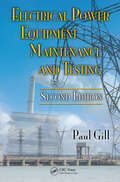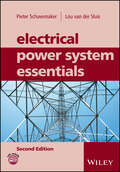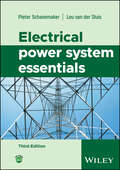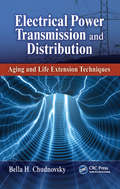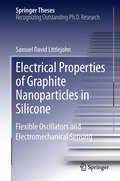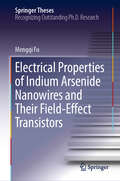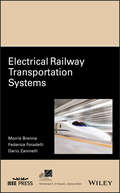- Table View
- List View
Electrical Energy Storage in Transportation Systems
by Benoît Robyns Xavier Roboam Daniel Hissel Christophe Saudemont Bruno Sareni Julien PougetThis book deals with the management and valuation of energy storage in electric power grids, highlighting the interest of storage systems in grid applications and developing management methodologies based on artificial intelligence tools. The authors highlight the importance of storing electrical energy, in the context of sustainable development, in ""smart cities"" and ""smart transportation"", and discuss multiple services that storing electrical energy can bring. Methodological tools are provided to build an energy management system storage following a generic approach. These tools are based on causal formalisms, artificial intelligence and explicit optimization techniques and are presented throughout the book in connection with concrete case studies.
Electrical Engineering for Non-Electrical Engineers
by S. Bobby RaufEngineers and non-engineers often eschew electrical engineering because it is premised on concepts and mathematical techniques that are somewhat more abstract and elusive than those employed in disciplines like civil, mechanical, and industrial engineering. Yet, because of the ubiquitous nature of electrical and electronic equipment and devices, and the indispensable role electricity plays in various facets of lives, a basic understanding of electrical engineering is essential. Engineers and non-engineers find themselves interfacing with electrical apparatus and dealing with matters that permeate into the electrical realm. Therein lies the purpose and objective of this book. This edition includes numerous updated pictures, diagrams, tables, charts, graphs, and improved explanation of certain concepts.
Electrical Fluctuations in Polyelectrolytes
by José Antonio FornésThis brief is the result of the research the author has performed in recent years covering electrical fluctuations in numerous systems, including molecular electrical fluctuations, ionic fluctuations, ionic dielectric relaxation, spherical and cylindrical polyelectrolytes, ionic polarizability in polyelectrolytes, pH fluctuation in vesicles and electrical fluctuations in proteins. The importance of estimating electrical fluctuations resides in its richness of information and omnipresence in biological systems. In order to understand how these systems work it is vital to know the magnitude of their electrical fluctuations. Electromagnetic fluctuations are the origin of London (Van der Waals) forces between molecules, and Lifshitz forces between macro objects. Protonic fluctuations are the origin of Kirkwood and Shumaker forces between molecules and pH fluctuations. Furthermore, protonic fluctuations could be the cause of the dielectric increment of proteins in solution. Local electrical fluctuations can influence chemical reactions and so on. This book addresses the interplay of these pervasive phenomena. .
Electrical Impedance Tomography: Methods, History and Applications (Series in Medical Physics and Biomedical Engineering)
by David HolderWith contributions from leading international researchers, this second edition of Electrical Impedance Tomography: Methods, History and Applications has been fully updated throughout and contains new developments in the field, including sections on image interpretation and image reconstruction. Providing a thorough review of the progress of EIT, the present state of knowledge, and a look at future advances and applications, this accessible reference will be invaluable for mathematicians, physicists dealing with bioimpedance, electronic engineerers involved in developing and extending its applications, and clinicians wishing to take advantage of this powerful imaging method. Key Features: Fully updated throughout, with new sections on image interpretation and image reconstruction Overview of the current state of experimental and clinical use of EIT as well as active research developments Overview of related research in geophysics, industrial process tomography, magnetic-resonance and magnetic-inductionimpedance imaging
Electrical Impedance: Principles, Measurement, and Applications (ISSN)
by Luca CallegaroElectrical Impedance: Principles, Measurement, and Applications provides a modern and much-needed overview of electrical impedance measurement science and its application in metrology, sensor reading, device and material characterizations. It presents up-to-date coverage of the theory, practical methods, and modeling. The author covers the main imp
Electrical Installation Work: Level 2 (EAL Edition)
by Mark Baker Peter RobertsThe only EAL approved textbook for the Level 2 Diploma in Electrical Installation (600/6724/X) Fully up-to-date with the 3rd Amendment of the 17th Edition IET Wiring Regulations Expert advice that has been written in collaboration with EAL to ensure that it covers what learners need to know in order to pass their exams Extensive online material to help both learners and lecturers Written specifically for the EAL Diploma in Electrical Installation, this book has a chapter dedicated to each unit of the syllabus. Every learning outcome from the syllabus is covered in highlighted sections, and there is a checklist at the end of each chapter to ensure that each objective has been achieved before moving on to the next section. End of chapter revision questions will help you to check your understanding and consolidate the key concepts learned in each chapter. Fully up to date with the third amendment of the 17th Edition Wiring Regulations, this book is a must have for all learners working towards EAL electrical installations qualifications.
Electrical Level 1
by NccerThis exceptionally produced trainee guide features a highly illustrated design, technical hints and tips from industry experts, review questions and a whole lot more! Key content includes: Orientation to the Electrical Trade, Electrical Safety, Introduction to Electrical Circuits, Electrical Theory, Introduction to the National Electrical Code, Device Boxes, Hand Bending, Raceways and Fittings, Conductors and Cables, Basic Electrical Construction Drawings, Residential Electrical Services, and Electrical Test Equipment.
Electrical Machine Drives Control: An Introduction
by Valeria Hrabovcova Juha Pyrhonen R. Scott SemkenThis comprehensive text examines existing and emerging electrical drive technologies. The authors clearly define the most basic electrical drive concepts and go on to explain the most important details while maintaining a solid connection to the theory and design of the associated electrical machines. Also including links to a number of industrial applications, the authors take their investigation of electrical drives beyond theory to examine a number of practical aspects of electrical drive control and application. Key features: * Provides a comprehensive summary of all aspects of controlled-speed electrical drive technology including control and operation. * Handling of electrical drives is solidly linked to the theory and design of the associated electrical machines. Added insight into problems and functions are illustrated with clearly understandable figures. * Offers an understanding of the main phenomena associated with electrical machine drives. * Considers the problem of bearing currents and voltage stresses of an electrical drive. * Includes up-to-date theory and design guidelines, taking into account the most recent advances. This book's rigorous coverage of theoretical principles and techniques makes for an excellent introduction to controlled-speed electrical drive technologies for Electrical Engineering MSc or PhD students studying electrical drives. It also serves as an excellent reference for practicing electrical engineers looking to carry out design, analyses, and development of controlled-speed electrical drives.
Electrical Machines and Their Applications
by Ali Mehrizi-SaniThis popular, easy-to-read book offers a comprehensive yet unique treatment of electrical machines and their historical development. Electrical Machines and Their Applications, Third Edition covers an in-depth analysis of machines augmented with ample examples, which makes it suitable for both those who are new to electric machines and for those who want to deepen their knowledge of electric machines. This book provides a thorough discussion of electrical machines. It starts by reviewing the basics of concepts needed to fully understand the machines, e.g., three-phase circuits and fundamentals of energy conversion, and continues to discuss transformers, induction machines, synchronous machines, dc machines, and other special machines and their dynamics. This natural progression creates a unifying theme and helps the reader appreciate how the same physical laws of energy conversion govern the operation and dynamics of different machine types. The text is sprinkled with ample examples to further solidify the discussed concepts. Several well-placed appendices make the book self-contained and even easier to follow. This book is part of a series on power system topics originally authored by the late Turan Gönen. The book has been edited by Ali Mehrizi-Sani to bring it up to date while maintaining its original charm. Both new and seasoned readers for Gönen’s books will find this new edition a much-awaited update to the second edition.
Electrical Machines with MATLAB
by Turan GonenElectrical Machines with MATLAB encapsulates the invaluable insight and experience that eminent instructor Turan Gonen has acquired in almost 40 years of teaching. With simple, versatile content that separates it from other texts on electrical machines, this book is an ideal self-study tool for advanced students in electrical and other areas of eng
Electrical Machines: Fundamentals of Electromechanical Energy Conversion
by Jacek F. GierasThis book endeavors to break the stereotype that basic electrical machine courses are limited only to transformers, DC brush machines, induction machines, and wound-field synchronous machines. It is intended to serve as a textbook for basic courses on Electrical Machines covering the fundamentals of the electromechanical energy conversion, transformers, classical electrical machines, i.e., DC brush machines, induction machines, wound-field rotor synchronous machines and modern electrical machines, i.e., switched reluctance machines (SRM) and permanent magnet (PM) brushless machines. In addition to academic research and teaching, the author has worked for over 18 years in US high-technology corporative businesses providing solutions to problems such as design, simulation, manufacturing and laboratory testing of large variety of electrical machines for electric traction, energy generation, marine propulsion, and aerospace electric systems.
Electrical Materials: Performance Improvement, Recent Advances and Engineering Applications (Engineering Materials)
by Peng Wang Jun Xie Yiyi ZhangThis book highlights the latest advances in advanced insulating materials. Energy crisis and environmental pollution are two major themes currently faced by the human society. It is of unprecedented strategic importance to construct a strong smart grid with super/ultra-high voltage network as the backbone and clean energy transmission as the leading force. However, the performance of electrical equipment and devices is greatly determined by the properties of their insulating materials, especially when they have to work in extreme circumstances including high-temperature differences, intense radiation, and strong electric fields. The key advantage of polymers is that their properties could be adjusted by changing their chemical composition and molecular structure. Research on polymer insulating materials has been highly successful as progress has been made in characterizing these properties, designing molecular structures, and studying polymers’ specialized properties. On the other hand, nanodielectrics are prepared by adding certain nanoscale fillers into a polymer matrix to yield better electrical, thermal, and mechanical properties. When the particle pretreatment methods and the content or category of fillers are adjusted, nanodielectrics tend to have greater breakdown strength as well as better high-temperature resistance and space charge suppression. Therefore, this book covers investigations of properties of insulating materials that explore their interface effects and composite structures and introduces findings in methods that improve the performance of electrical devices. The book is not only used as a timely reference for engineering and technical personnel in related fields but also as a comprehensive textbook for college students.
Electrical Motor Controls for Integrated Systems
by Glen A. Mazur Gary RockisElectrical Motor Controls for Integrated Systems is the industry-leading textbook covering electrical, motor, and mechanical devices and their use in automated systems and industrial control circuits. Topics are organized into sections for modular instruction and can easily be used in seminars and in online educational settings. This edition includes motor control and integrated systems technology for instruction of advanced manufacturing skills. The industry practices complement the advancing technology of motor starters, motor drives, PLCs, semiconductors, and control devices. Essential troubleshooting procedures are integrated into each chapter, and electrical safety has been expanded throughout.
Electrical Neuroimaging
by Christoph M. Michel Thomas Koenig Daniel Brandeis Jiří Wackermann Lorena R. R. GianottiElectrical neuroimaging is based on the analysis of brain electrical activity recorded from the human scalp with multichannel EEG. It offers enormous potential for the dynamic mapping of brain functions, and for the non-invasive diagnosis of neurological and psychiatric conditions. This authoritative reference gives a systematic overview of new electrical imaging methods, with a sound introduction to the basics of multichannel recording of EEG and event-related potential (ERP) data, as well as spatio-temporal analysis of the potential fields. The book enables researchers to measure valid data, select and apply appropriate analysis strategies, and avoid the most common mistakes when analyzing and interpreting EEG/ERP data. Importantly, it informs the research communities of the possibilities opened by these space-domain oriented approaches to the analysis of brain electrical activity, and of their potential to offer even more powerful diagnostic techniques when integrated with other clinically relevant data.
Electrical Oscillators
by Nikola TeslaNikola Tesla was a genius who revolutionized how the world looks at electricity. In 1893 he patented an electro-mechanical oscillator as a steam-powered electric generator. By his own account, one version of the oscillator caused an earthquake in New York City in 1898, for which it was accorded the moniker, "Tesla's earthquake machine."
Electrical Phenomena at Interfaces and Biointerfaces
by Hiroyuki OhshimaThis book bridges three different fields: nanoscience, bioscience, and environmental sciences. It starts with fundamental electrostatics at interfaces and includes a detailed description of fundamental theories dealing with electrical double layers around a charged particle, electrokinetics, and electrical double layer interaction between charged particles. The stated fundamentals are provided as the underpinnings of sections two, three, and four, which address electrokinetic phenomena that occur in nanoscience, bioscience, and environmental science. Applications in nanomaterials, fuel cells, electronic materials, biomaterials, stems cells, microbiology, water purificiaion, and humic substances are discussed.
Electrical Phenomena at Interfaces: Fundamentals: Measurements, and Applications (Surfactant Science Ser. #76)
by Hiroyuki Ohshima Kunio FurusawaRevising, updating and expanding information on developments since the late 1980s, the second edition of this work presents practical, fundamental material on interfacial electric phenomena in acqueous and nonaqueous systems, as well as their relation to colloid stability. The book includes 15 additional chapters that reflect collaborative efforts with new experts in the field.
Electrical Power Equipment Maintenance and Testing (Second Edition)
by Paul GillThe second edition of a bestseller, this definitive text covers all aspects of testing and maintenance of the equipment found in electrical power systems serving industrial, commercial, utility substations, and generating plants. It addresses practical aspects of routing testing and maintenance and presents both the methodologies and engineering basics needed to carry out these tasks. It is an essential reference for engineers and technicians responsible for the operation, maintenance, and testing of power system equipment. Comprehensive coverage includes dielectric theory, dissolved gas analysis, cable fault locating, ground resistance measurements, and power factor, dissipation factor, DC, breaker, and relay testing methods.
Electrical Power System Essentials
by Lou van der Sluis Pieter SchavemakerThe electrical power supply is about to change; future generation will increasingly take place in and near local neighborhoods with diminishing reliance on distant power plants. The existing grid is not adapted for this purpose as it is largely a remnant from the 20th century. Can the grid be transformed into an intelligent and flexible grid that is future proof? This revised edition of Electrical Power System Essentials contains not only an accessible, broad and up-to-date overview of alternating current (AC) power systems, but also end-of-chapter exercises in every chapter, aiding readers in their understanding of the material introduced. With an original approach the book covers the generation of electric energy from thermal power plants as from renewable energy sources and treats the incorporation of power electronic devices and FACTS. Throughout there are examples and case studies that back up the theory or techniques presented. The authors set out information on mathematical modelling and equations in appendices rather than integrated in the main text. This unique approach distinguishes it from other text books on Electrical Power Systems and makes the resource highly accessible for undergraduate students and readers without a technical background directly related to power engineering. After laying out the basics for a steady-state analysis of the three-phase power system, the book examines: generation, transmission, distribution, and utilization of electric energy wind energy, solar energy and hydro power power system protection and circuit breakers power system control and operation the organization of electricity markets and the changes currently taking place system blackouts future developments in power systems, HVDC connections and smart grids The book is supplemented by a companion website from which teaching materials can be downloaded.
Electrical Power System Essentials
by Pieter Schavemaker Lou van der SluisA highly accessible resource covering the basics of the design and operation of electrical power systems with minimal technical background required Electrical Power System Essentials delivers a thorough introduction to the electrical power system and its functioning, and the changes that come with the worldwide energy transition process. This revised and updated Third Edition includes new material on HVDC developments, electricity markets, capacity calculation (NTC and flow-based), power system protection, and energy storage. Discussions on how renewable sources play a more dominant role in the generation of electrical energy and the effects they have on the control and operation of the grid and electricity markets are also included. Written in the accessible style that has made previous editions so popular with readers, this book restricts math content to the Appendix in order to maintain an easy reading experience of the main text while still providing complete coverage. A companion website includes downloadable teaching materials, and accessory videos are viewable on the Wiley website (www.wiley.com/go/powersystem3e) and YouTube (https://www.youtube.com/playlist?list=PLvaU1SY38TUV8JTwkf1taN-w_bQbCD0Ad). Topics discussed in the book include: Generation of electric energy, covering nuclear fission, wind energy and wind turbine concepts, hydropower and pumped storage, and solar powerElectricity markets, covering gas scarcity, its influence on the marginal price of electricity, and negative energy pricesFuture power systems, covering higher harmonics, increased use of cables instead of overhead transmission lines, distributed generation and power-electronic interfacesTransmission of electric energy, covering DC circuit breakers, wide area measurement systems, and distribution networks Electrical Power System Essentials is a perfect textbook for second- and third-year undergraduate electrical engineering students who need an accessible course text introducing concepts in power system engineering. The text is also valuable for other students and professionals who require an up-to-date reference on power systems technology.
Electrical Power Transmission and Distribution: Aging and Life Extension Techniques
by Bella H. ChudnovskyElectrical distribution and transmission systems are complex combinations of various conductive and insulating materials. When exposed to atmospheric corrosive gases, contaminants, extreme temperatures, vibrations, and other internal and external impacts, these systems deteriorate, and sooner or later their ability to function properly is destroyed. Electrical Power Transmission and Distribution: Aging and Life Extension Techniques offers practical guidance on ways to slow down the aging of these electrical systems, improve their performance, and extend their life. Recognize the Signs of Aging in Equipment—and Learn How to Slow It A reference manual for engineering, maintenance, and training personnel, this book analyzes the factors that cause materials to deteriorate and explains what you can do to reduce the impact of these factors. In one volume, it brings together extensive information previously scattered among manufacturers’ documentation, journal papers, conference proceedings, and general books on plating, lubrication, insulation, and other areas. Shows you how to identify the signs of equipment aging Helps you understand the causes of equipment deterioration Suggests practical techniques for protecting electrical apparatus from deterioration and damage Supplies information that can be used to develop manuals on proper maintenance procedures and choice of materials Provides numerous examples from industry This book combines research and engineering material with maintenance recommendations given in layperson’s terms, making it useful for readers from a range of backgrounds. In particular, it is a valuable resource for personnel responsible for the utilization, operation, and maintenance of electrical transmission and distribution equipment at power plants and industrial facilities.
Electrical Properties of Graphite Nanoparticles in Silicone: Flexible Oscillators and Electromechanical Sensing
by Samuel David LittlejohnThis thesis examines a novel class of flexible electronic material with great potential for use in the construction of stretchable amplifiers and memory elements. Most remarkably the composite material produces spontaneous oscillations that increase in frequency when pressure is applied to it. In this way, the material mimics the excitatory response of pressure-sensing neurons in the human skin. The composites, formed of silicone and graphitic nanoparticles, were prepared in several allotropic forms and functionalized with naphthalene diimide molecules. A systematic study is presented of the negative differential resistance (NDR) region of the current-voltage curves, which is responsible for the material's active properties. This study was conducted as a function of temperature, graphite filling fraction, scaling to reveal the break-up of the samples into electric field domains at the onset of the NDR region, and an electric-field induced metal-insulator transition in graphite nanoparticles. The effect of molecular functionalization on the miscibility threshold and the current-voltage curves is demonstrated. Room-temperature and low-temperature measurements were performed on these composite films under strains using a remote-controlled, custom-made step motor bench.
Electrical Properties of Indium Arsenide Nanowires and Their Field-Effect Transistors (Springer Theses)
by Mengqi FuThis book explores the impacts of important material parameters on the electrical properties of indium arsenide (InAs) nanowires, which offer a promising channel material for low-power electronic devices due to their small bandgap and high electron mobility. Smaller diameter nanowires are needed in order to scale down electronic devices and improve their performance. However, to date the properties of thin InAs nanowires and their sensitivity to various factors were not known. The book presents the first study of ultrathin InAs nanowires with diameters below 10 nm are studied, for the first time, establishing the channel in field-effect transistors (FETs) and the correlation between nanowire diameter and device performance. Moreover, it develops a novel method for directly correlating the atomic-level structure with the properties of individual nanowires and their device performance. Using this method, the electronic properties of InAs nanowires and the performance of the FETs they are used in are found to change with the crystal phases (wurtzite, zinc-blend or a mix phase), the axis direction and the growth method. These findings deepen our understanding of InAs nanowires and provide a potential way to tailor device performance by controlling the relevant parameters of the nanowires and devices.
Electrical Properties of Tissues: Quantitative Magnetic Resonance Mapping (Advances in Experimental Medicine and Biology #1380)
by Rosalind Sadleir Atul Singh MinhasThis book covers the latest developments in tissue electrical conductivity and current density imaging, increasingly popular as well as challenging applications of MRI. These applications are enabled by the acquisition of high-quality MR phase images. This book provides a practical description of the MRI physics needed to understand and acquire phase images in MRI and the key details required to reconstruct them into conductivity, current density or electric field distributions. Comprehensive details are provided about the electrical properties of biological tissues, computational modeling considerations, experimental methods, construction of non-biological and biological phantoms and MRI pulse sequences. An inclusive review of image reconstruction algorithms, and their potential applications is provided for applications directed at determining current density or electric fields, such as in transcranial DC or AC stimulation techniques; as well as electrical conductivity reconstructions that may be of use in quantitative MRI applications used to detect cancer or other pathologies. This is an excellent book for undergraduate and graduate students beginning to explore phase, current density, and conductivity imaging in MRI, and will also be of great use to researchers interested in the area of MR-based electrical property imaging.
Electrical Railway Transportation Systems (IEEE Press Series on Power Engineering)
by Morris Brenna Federica Foiadelli Dario ZaninelliAllows the reader to deepen their understanding of various technologies for both fixed power supply installations of railway systems and for railway rolling stock This book explores the electric railway systems that play a crucial role in the mitigation of congestion and pollution caused by road traffic. It is divided into two parts: the first covering fixed power supply systems, and the second concerning the systems for railway rolling stock. In particular, after a historical introduction to the framework of technological solutions in current use, the authors investigate electrification systems for the power supply of rail vehicles, trams, and subways. Electrical Railway Transportation Systems explores the direct current systems used throughout the world for urban and suburban transport, which are also used in various countries for regional transport. It provides a study of alternating current systems, whether for power supply frequency or for special railway frequency, that are used around the world for the electrification of railway lines, long-distance lines, and high-speed lines. In addition, this resource: Analyzes multiple railway systems from a theoretical and realizable vantage point, with particular regard to functionality, electromagnetic compatibility, and interferences with other electrical systems Studies electric traction railway vehicles, presenting various types of drives and auxiliary devices currently in circulation Discusses solutions employed to ensure interoperability of vehicles that run along lines powered by different systems (e.g., DC and AC, at different frequencies) Electrical Railway Transportation Systems is an ideal text for graduate students studying the subject as well as for industry professionals working in the field.

